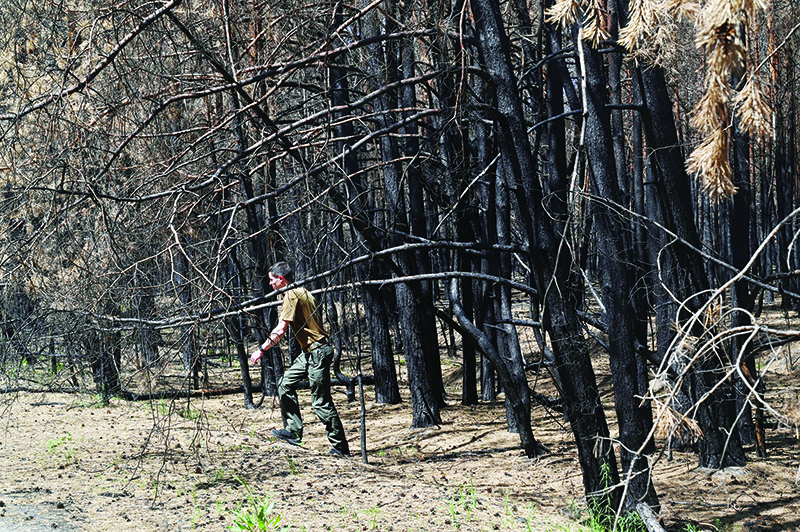
CHERNOBYL EXCLUSION ZONE, Ukraine: Ukrainian scientist Oleksandr Borsuk looks bitterly at the charred trunks of old pine trees as the acrid smell of burnt wood hangs in the air. The scene he is taking in would not be out of place on the set of a sci-fi post-apocalyptic movie.
In the spring a huge fire battered the Chernobyl exclusion zone, devastating the lush forests at the scene of the world’s worst nuclear accident and dealing a major blow to its ecosystem. “This pine forest will never be reborn,” Borsuk, the 32-year-old head of the flora and fauna lab at the Chernobyl reserve, told AFP, adding a new ecosystem will form in its place.
The fire, which broke out in April and was only put out in mid-May, reached to within just 1.5 kilometers of the protective dome over a ruined reactor, according to Greenpeace. The blaze—the largest since the 1986 catastrophe—spanned 66,000 hectares (14.8 acres), including 42,000 hectares of forests.
The fire also tore through 10 abandoned villages and an old cemetery near the village of Rozsokha, leaving behind burnt iron crosses and charred nameplates.
Several pine trees fell across the tombs. Authorities said that no increase in radiation levels had been detected and there were no human casualties.
Local wildlife has not been spared, however.
While birds and large animals such as wolves, elks and lynxes managed to escape, some small mammals like hares as well as snakes and other reptiles perished.
Speaking on a tour of the devastated areas, Borsuk said it was still too early to assess the full damage but noted that the conifer forests were hit hardest.
“It takes a long time for conifers to regenerate,” he said. “The trees will be dying for the next two to three years.” Most of the forests will survive, however, he added.
‘Animals are returning’
Denys Vyshnevsky, head of science at the Chernobyl reserve, said a lot of plants had died but the worst had been avoided. “We are constantly monitoring and we are seeing positive trends,” he said.
“The animals are returning. The birds are already returning,” he added. Even areas completely devastated by the fire will regenerate in a few years, Vyshnevsky said. Experts say the fire, which came from outside the exclusion zone, was caused by an unusually dry winter and spring, which allowed the blaze to spread very quickly.
Vyshnevsky warned that such large-scale fires can happen again, as climate change takes hold. He said the country needed to prepare and learn from the United States and southern Europe where major fires are common.
“We have to overhaul the entire system of surveillance, prevention and emergency response,” he said. More than a thousand firefighters and aircraft were involved in battling the blaze and at one point, thick smog reached the capital Kiev. Rain eventually came to the rescue.
Chernobyl polluted a large swathe of Europe when its fourth reactor exploded in April, 1986. People are not allowed to live within 30 kilometers (18 miles) of the power station. After the explosion, the three other reactors at Chernobyl continued to generate electricity until the power station finally closed in 2000. A giant protective dome was put in place over the fourth reactor in 2016. – AFP










